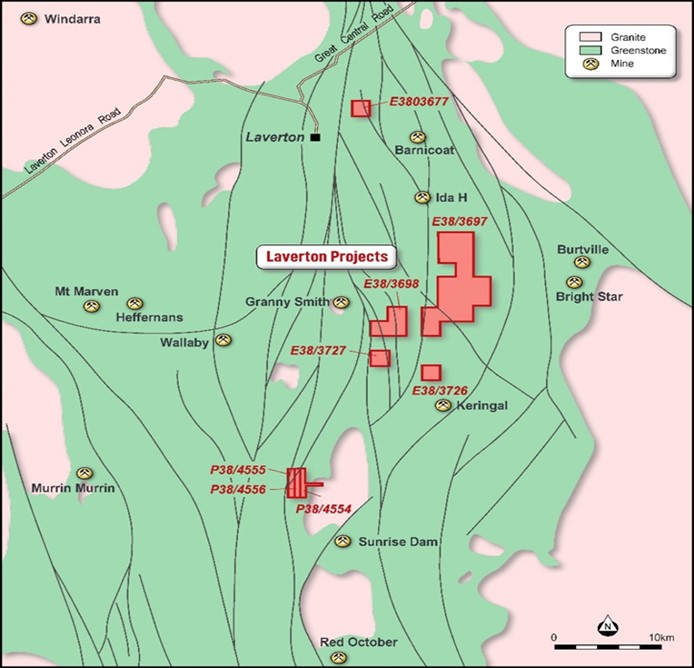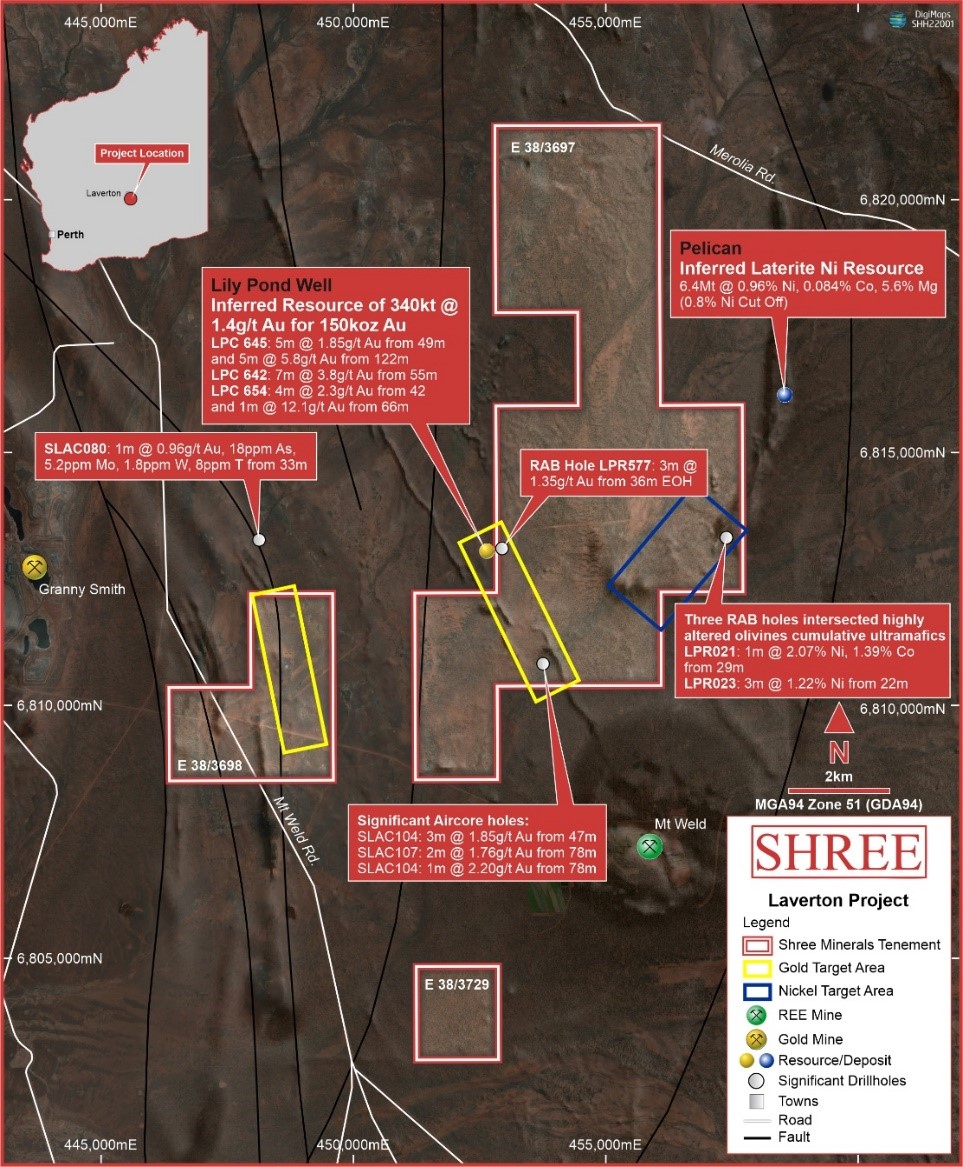Laverton
The applications are located within the Laverton Gold Province, which is known to contain some 30 million ounces of gold, making it the second highest endowed gold district in Western Australia behind Kalgoorlie. The Laverton gold district is also the highest growth gold district in Australia over the last 25 years. The region hosts several important gold and nickel deposits including Sunrise Dam (>10Moz), Wallaby (> 8Moz), Granny Smith (>2Moz, closed) and Lancefield (>2Moz, closed), Windara Nickel (combined 85K tonnes nickel sulphide).
Lynas Corporation also operates the Mt Weld Rare Earth Element (REE) operation only 2 kms to the south of Shree’s application E38/3697, figure 2.
SHH has identified a series of very prospective under-cover gold and nickel mineralisation drill targets within the tenements. The targets have been generated through an integrated approach using detailed interpretation of aeromagnetic and gravity images, historical exploration drilling programs and the mineralisation models developed from the neighbouring world class gold deposits.
 Figure 1. Regional location diagram, showing surrounding mines.
Figure 1. Regional location diagram, showing surrounding mines.
Gold Targets
A very compelling target comprising undercover and fault-offset gold mineralisation which may be related to the outcropping Lily Pond Well (LPW) mineralisation (not SHH), figure2.
The Lily Pond Well Au deposit was identified by Sons of Gwalia in 1999 and contains an inferred resource of 340,000 tonnes @ 1.4 g/t Au for 15,000 ozs Au . Significantly, the Lily Pond Well deposit closely resembles the geological setting of the world class Wallaby Gold Deposit, located only 25 kms to the west. At LPW, interleaved mafic conglomerates, mafic and graphitic
schists, pelitic and psammitic sediments and felsic fragmental rocks are spatially related to a strongly altered felsic intrusive. Narrow zones of quartz-sulphide veining, with albite sericite altered selvedges, average between 1 and 6 g/t Au.
Intersections at LPW include 5m @ 1.7 g/t Au from 49m, 2m @ 2.9 g/t Au from 98m and 5m @ 5.81 g/t Au from 122m in the same hole (LPC645). Other intersections include 7m @ 3.84 g/t Au from 55m, 1m @ 12.1 g/t Au from 66m and 6m @ 2.03 g/t Au. Occurring just 200m to the east of the LPW deposit, and within Shree’s application (EL38/3697), historic drillhole LPR577 (Figure 2) intersected 3m @ 1.36 g/t Au from 36m downhole depth, which is part of a broader anomalous intersection that extends to EOH. Additionally, very significant and mineralised air core holes situated 2 kms to the SE of the LPW resource (figure 2) include:
- SLAC104: 3m @ 1.85 g/t Au from 41m.
- SLAC107: 2m @ 1.76 g/t Au from 61m.
- SLAC109: 1m @ 2.2 g/t Au from 78m.
Connecting the LPW deposit and these SLAC air core holes is a prominent regional, SE-NW orientated aeromagnetic structure, with sinistral off-sets, suggesting the structural controls on the LPW mineralisation may be present, figure 2.
 Figure 2. Summary diagram, showing historical salient features of the prospectivity around Shree’s Laverton projects. Background image is the regional aeromagnetics.
Figure 2. Summary diagram, showing historical salient features of the prospectivity around Shree’s Laverton projects. Background image is the regional aeromagnetics.
Nickel Targets
The Pelican Laterite Nickel Resource (not SHH) was discovered by Anaconda Nickel in 1999 and contains an Inferred Nickel Resource of 6.4 Mt @ 0.96% Ni, 0.84% Co, 5.6% Mg, at a 0.8% Ni cut-off, figure 2. Host rocks include a weathered ultramafic known as the Pelican Ultramafic and consists of smectite and saprolitic clays. Highly anomalous nickel in laterite geochemistry occurs over a length of 8 kms within the Pelican Ultramafic belt.
Rare, deeper drilling into the weathered profile intersected a serpentinised olivine cumulate komatiite at Pelican, a favourable host rock for nickel sulphide mineralisation at the Mount Keith, Windara, and the Perseverance nickel deposits. Drilling did not extend to depth often enough to test for the presence of nickel sulphide mineralisation at Pelican.
In 2008, Placer Exploration drilled three shallow RAB holes within the Pelican Ultramafic in the area now covered by EL38/3697, figure 2. Significantly, Placer geologists identified highly altered olivine cumulate textured komatiites within these holes. The area corresponds to a significant thickening of the Pelican aeromagnetic anomaly. Intersections include 1m @ 2.07% Ni, 1.39% Co and 3m @ 1.22% Ni. Unfortunately, the rocks were not assayed for pathfinder geochemistry associated with nickel mineralisation, including Cu, Cr, and PGE’s. There has been no follow up exploration of this target since Placer’s work.
The aeromagnetic image and the RAB holes together provide a significant and compelling drill target for nickel sulphide mineralisation, illustrated by the blue rectangle in Figure 2.
REE Targets
The Mt Weld rare earths mine located just 2 kms south of Shree’s EL38/3697 is one of the highest-grade rare-earth mines operating in the world. The project is owned and operated by Lynas.
Rare earths are contained in secondary phosphates and aluminophosphates, presumably derived from weathering of the Proterozoic Mount Weld carbonatite. The primary commercial interest at the site is targeted towards oxides within the magnetic circular pipe of the Mount Weld carbonatite.
Occurring within EL38/3697 are several small diameter aeromagnetic bullseye features seen within the aeromagnetic images, figure 2. Shree will evaluate these features for MT Weld style mineralisation concurrently with the exploration programs discussed above.
Location Map

